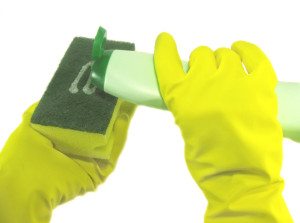Though you keep it clean, fighting germs in the kitchen may be a bigger battle than you realize. Several recent studies have revealed what no one wants to hear: germs are potentially more prevalent in the kitchen than in the bathroom. The risk of illness is greatly increased in the  kitchen, where pathogens can easily mix with and contaminate food. Read on for a list of trouble spots as well as tips and tricks for cleaning and sanitizing.
kitchen, where pathogens can easily mix with and contaminate food. Read on for a list of trouble spots as well as tips and tricks for cleaning and sanitizing.
The Germiest Spots in Your Kitchen
The National Sanitation Foundation has identified the top six “germiest” kitchen locations or items as: refrigerator vegetable compartments, refrigerator meat compartments, blender gaskets, can openers, rubber spatulas and any food storage container with a rubber seal.* The most common illness-causing microorganisms found in these locations were listeria, salmonella, E. coli, yeast and mold. Other top offenders included refrigerator ice and water dispensers, and door seals.
Winning the War with Kitchen Germs
To effectively clean the vegetable and meat compartments of your refrigerator, remove them and wash them thoroughly with warm water and mild detergent, using a clean sponge or cloth. Rinse well and wipe dry with a clean towel. If odors are present, rinse with a baking soda solution (one to two tablespoons to one quart of warm water) and dry. Clean these compartments and all refrigerator shelves and surfaces at least once per month and whenever you notice juices or liquid in or under them. A mixture of one tablespoon household bleach to one gallon of warm tap water can be used to sanitize most kitchen items, but be sure to check manufacturer’s instructions and rinse thoroughly. Household cleaners remove dirt and grease, but typically do not sanitize items. Fortunately you have an ally in your kitchen already: the dishwasher.
How Your Dishwasher Can Help Fight Germs
Your greatest weapon in the war on kitchen germs is your dishwasher. Run anything that is dishwasher-safe through a full cycle each time you use it. Fully disassemble your blender jar after each use and run all parts through the dishwasher. Remove the blade assembly from your electric can opener and do the same, or put your manual can opener through a cycle each time you use it. Check to make sure any rubberized parts of these small appliances are dishwasher-safe – many are not. If you must hand-wash these items, do so in hot, soapy water, paying special attention to any area where food can accumulate, then sanitize with bleach solution. Rinse thoroughly and allow to air dry before putting them away.
Keep your family safe from foodborne illness by making sure your kitchen stays sanitary. Contact Complete Appliance Repair in Salt Lake City for regular maintenance of your refrigerator and dishwasher and all your home appliances. Fighting germs in the kitchen is serious business, and Complete Appliance Repair can help.
*NSF 2013 household germ study,
http://www.nsf.org/newsroom_pdf/2013_germ_study_FOR-WEB-ONLY.pdf

